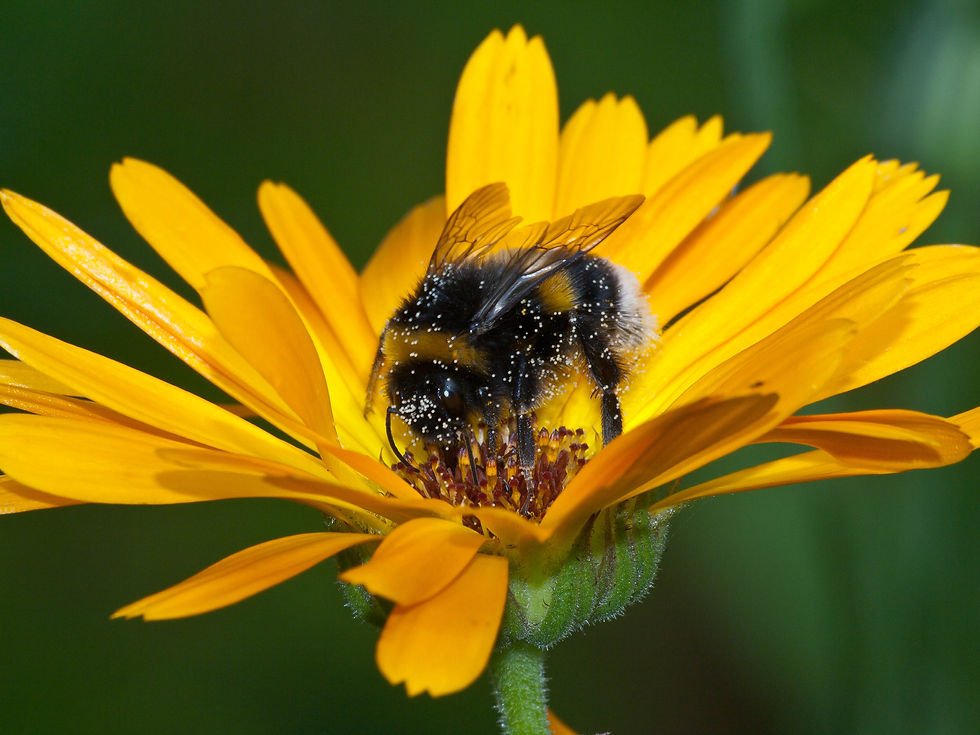What's the Deal with Bees?
- Chris Kapeller

- Aug 16, 2018
- 4 min read
Updated: Feb 28, 2021
Throughout history, bees have been playing an important role in several ecosystems worldwide acting as plant pollinators. Their work supports the development of many species that in turn support the ecosystems that thrive around them. Through pollinating they help the reproductive cycle of plants and it is estimated that ⅓ of the plants we consume in each day are mainly pollinated by bees followed by other insects and birds.
Bees are considered to be a keystone species :
A keystone species is a species that has a disproportionately large effect on its environment relative to its abundance. Without this species, ecosystem will collapse, even though it had a relatively small part of the ecosystem by productivity or biomass.
Honey Bees
Honey bees are of course most notable for their production of honey, and they are also the only species of bee that works together in colonies of thousands, sometimes upwards of 50-60 thousand workers in all. Honey bees are considered social bees, and their colonies function as ‘supercolonies’ which refers to an organized group of individuals working together as a whole unit, think “the whole is greater than the sum of its parts”. Due to the shear number of individuals in a colony, it is essential for the hive to work together like this, in order to provide enough for everyone and keep the hive in working order. Honey bees are often a convenient choice for ‘domesticating’ and using on farms through the practice of beekeeping, because of their very large colony size. This ensures a high number of bees are out pollinating, and can sustain a large volume of crops. Honey bees are essential to the pollination of many crops, and our dependence on them is important for the agricultural industry, as well as for many wild species of plants that support other ecosystems. The increase of pesticide use, habitat loss, and ‘colony collapse disorder’ is worrying in recent years, and this will be discussed in length later.
Bumblebees
On the other hand, bumblebees are found in much smaller colonies of around 50-400, but usually 100-200 individuals. Bumblebees can choose a variety of locations for nests, from grass clumps to rodent holes and even crevices in walls. Most bumblebee species are also social, like honey bees, and are great pollinators mainly due to their large furry bodies. This allows a large volume of pollen to stick to their fur and be transferred from flower to flower. Bumblebees are increasingly being used for commercial pollination, alongside and also separate from large honeybee colonies.
Mason Bees
Mason Bees don’t live in hives as they are solitary animals, but live in small nests or holes, sometimes left behind by other burrowing animals, or holes made by them. They use clay in the construction of their nests, which coined the term ‘mason’ bee. Mason bees are efficient pollinators, and are being used more and more along with honey and bumble bees. Mason bees can be encouraged to set up home in a mason bee house, which is a cluster of holes often drilled into a log or with a cluster of hollow canes. This ensures a large population of mason bees exist in that one location, and can pollinate more efficiently.
Decline in Bee Species
The decline in bee populations and complete extinction of some bee species has been widely reported in the last decade. While this issue is complex in many ways, it also has three distinct reasons for occurring. First is the use of harsh pesticides; in the agricultural industry as well as home gardens. Second is the rate at which habitats sufficient for bees are being destroyed. This happens for a number of reasons including land converted for use in the animal and crop agricultural industry, or new infrastructure for a city. The third is Colony Collapse Disorder, which still has a lot of mystery and confusion surrounding it. Colony Collapse Disorder is classified as an exceptional loss in honey bee population, higher than that usually seen in natural winter losses. CCD occurs when the majority of adult worker bees disappear from a hive, leaving behind mainly the queen, lots of stores of food, and nurse bees caring for the immature bees. The mechanisms behind CCD are still unknown, but many studies speculate it to be attributed to pesticide use, mite infestation, or harsh beekeeping practices (such as prolonged antibiotics use), just to name a few. It has also been linked to Climate change, and the various amount of issues that come with it. Climate change affects weather patterns, and thus when bees can be active out of the hive, and also the growth of flowers and production of nectar, possibly limiting what bees can forage for the hive. These factors combined demonstrate that bees are sensitive creatures, and change to their lifestyle severely impacts their survival, and therefore, the survival of many other creatures worldwide.
How can you help?
It can often seem like an issue as widespread as this has no one solution or an easy way to remedy it. However, every small step can help and every person can make a change. While it is harder to tackle the large corporations using harmful pesticides or destroying land for other uses, it is easy to start in your own yard. Firstly, by eliminating or reducing pesticide use in your garden it will make bees more likely to thrive, and have a safe environment to live in. The planting of wildflowers and flowers that attract bees is important, as this gives them more access to nectar that can sustain the hive.
If you'd like to get involved in your own garden, head to www.beesmatter.ca to get your own free seed packet to plant today!








Comments